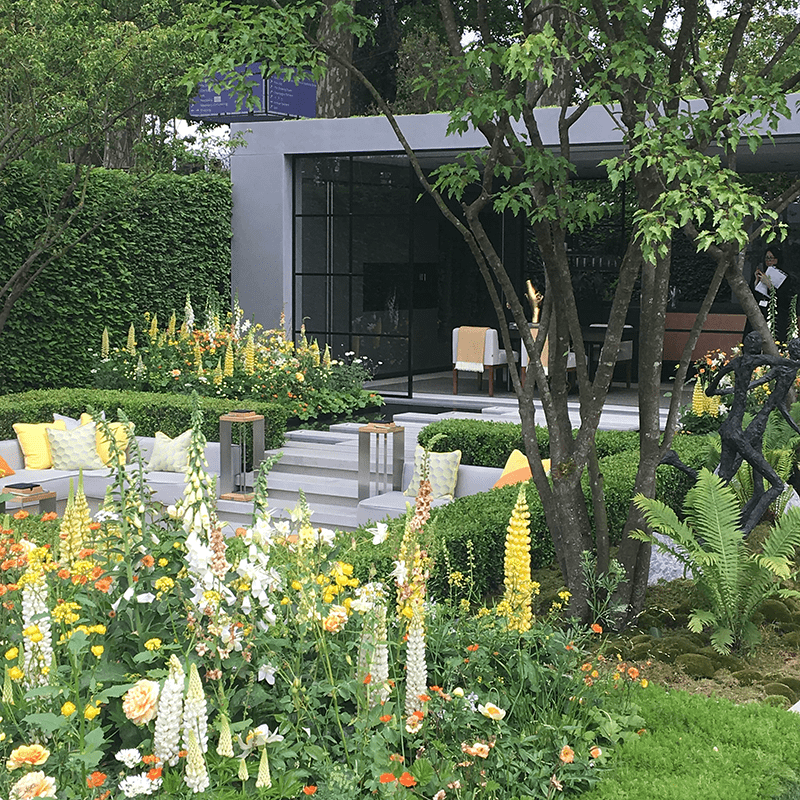
Whether a garden is designed by an amateur or a professional there are certain principles that form the basis of effective garden designs. Garden design elements include the layout of the hard landscape (paths, walls, water features, decking, sitting areas, and the plants).
Here are some classic garden design ideas and a guide to using lines when designing a garden:
1. Box Hedges
Many formal gardens have low to medium height box hedges as a common characteristic. They are typically formed into geometric shapes that enclose an informal mix of plantings. This is a style that works well in both large and small gardens. During the winter it is the formal framework that ensures the garden remains looking stylish. This is due to the hedges, which hide the stems of pruned roses or other bare beds. The following hedging plants are suitable for local use: Abelia 'Francis Mason', coleonema, Duranta 'Sheena's Gold', and lavender.
2. Herbaceous Borders
Many classic gardens feature the long herbaceous border. It is a perfect way to soften perimeter driveways and walls. Plants should be placed in groups of three, five, or seven (depending upon their size) and the chosen colours should complement each other. This will give the plantings more impact and repeating them at intervals will create a sense of rhythm in the garden design.
3. Seating Areas
Classic gardens are also known for their seating areas. The careful placement of an attractive seating area provides a place from which the garden can be admired. The seating could range from a weathered bench to a stone seat. The idea of a seating area can be taken to the next level by actually making the area a destination. For example, this can be accomplished by placing the seating under an arbour that is located at the end of a flower lined pathway or walkway.
4. Garden Rooms
Another very common design element of classic garden is the formulation of garden rooms. Generally the garden will be comprised of a number of garden rooms. Often the rooms will be screened off from the other rooms by high yew hedges. There may be openings in the hedges to reveal just glimpses of adjoining rooms. This piques the interest of the visitors to encourage them to explore the other garden rooms. These rooms can have their own theme of plantings and design. Dividing the garden into rooms can be accomplished by using wooden fencing, woven wattle screens or trellis covered over with trained creepers, or by planting quick growing hedging plants like eugenias and viburnum.
5. Focal Points
Creating a focal point is another design element of the classic garden. Using a simple urn at the centre of a courtyard or at the end of a path will create this focal point. This type of element will also work well in the midst of a bed or even half hidden in a growth of foliage. A classic urn planted with striking red amaryllis and placed on a raised plinth is an iconic classic garden design.
Considering Lines in Garden Design
Of all design elements, lines are one of the most useful and most important to consider. Lines are part of everything in the garden. For example, think about the line created when a lawn ends and adjacent woods being, or the line of the trunk of a tree, the distant horizon, a footpath, a fence, a driveway. These are all clear lines in the landscape so it is important to consider any line that will be created by the garden design choices. Lines can be described as curved, straight, horizontal, and vertical.
Strong lines can direct where people are supposed to look or stroll or to draw the eye into the landscape toward a particular focal point. While straight lines bring about a sense of crispness and order that is more formal, curved lines add a bit of interest to pathways and shape less formal garden beds. Vertical lines evoke a sense of movement and strength, while horizontal lines can be soothing and create a sense of stability. No type of line is more important than the other; they all carry equal value when it comes to designing a garden. All lines are desirable and necessary to evoke a certain feeling and lead the eye to focal points and destinations within the garden.
